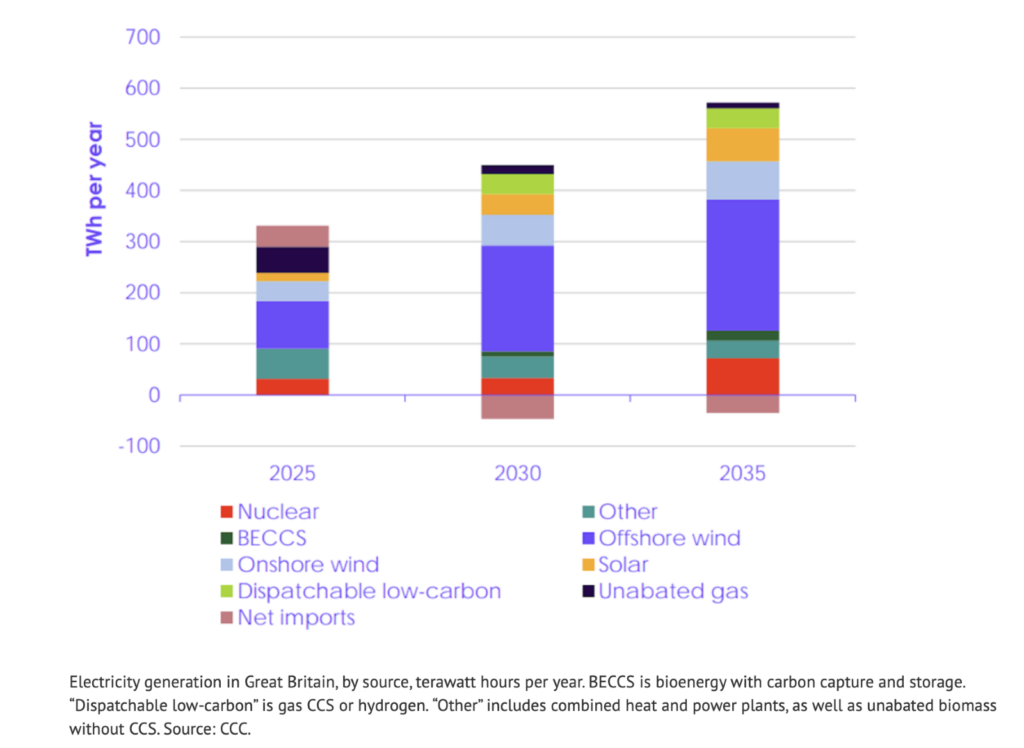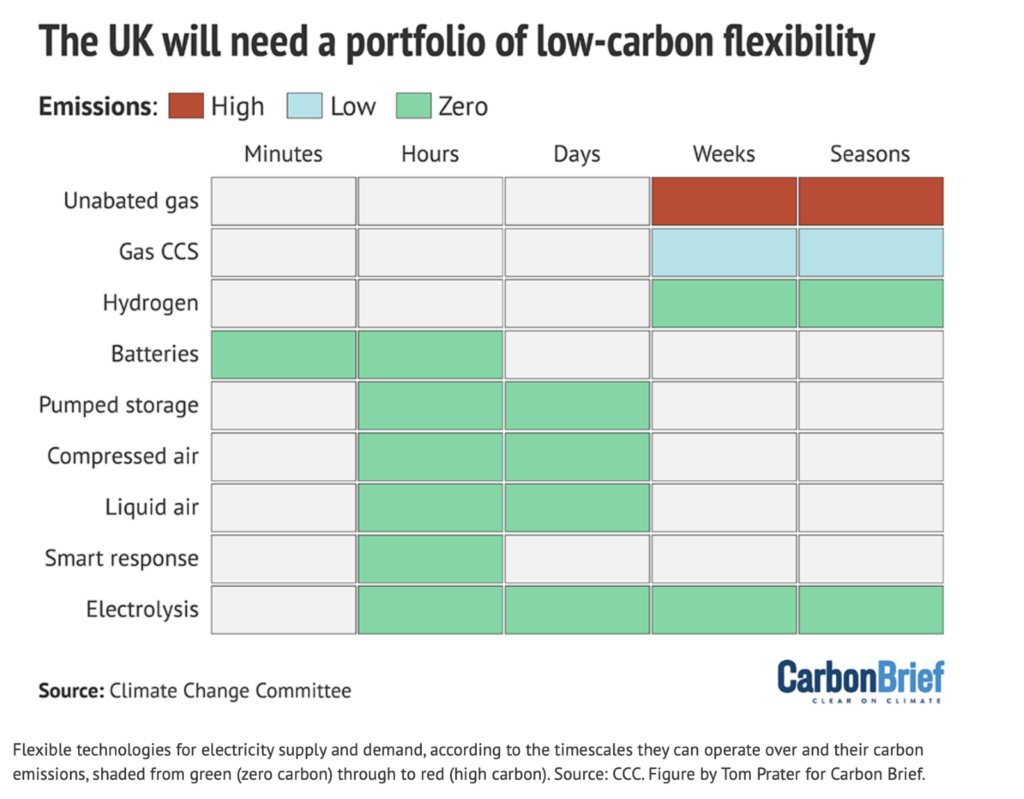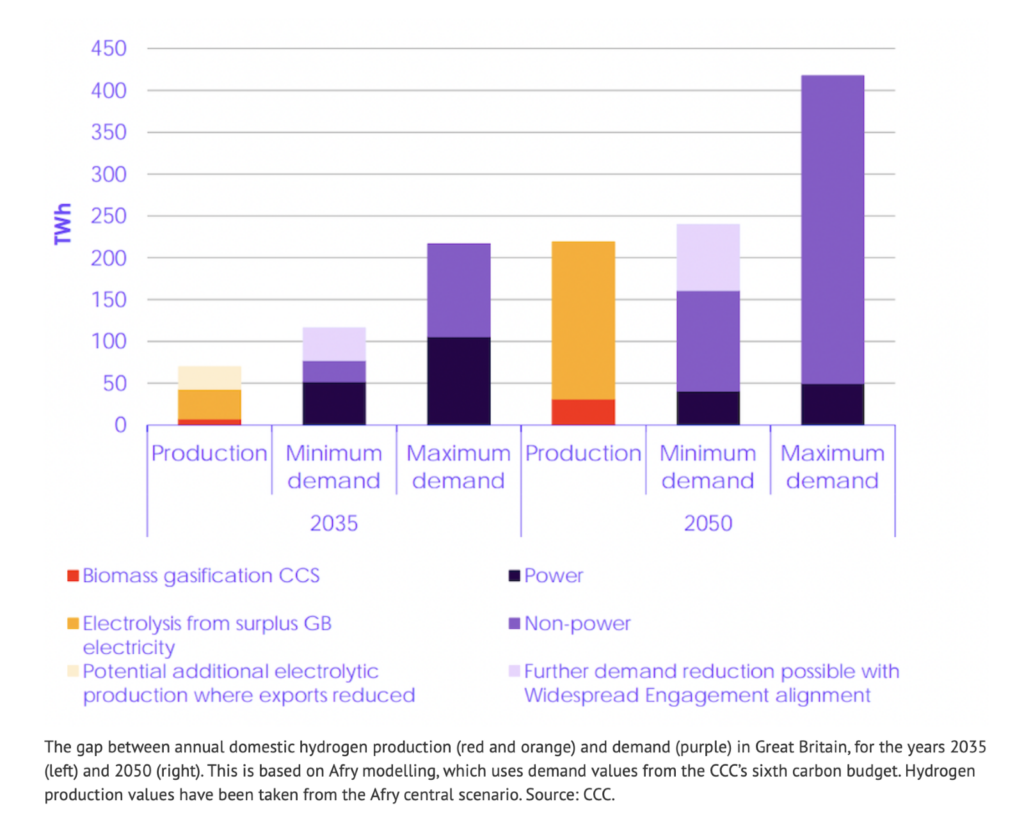Carbonbrief stellt einen Bericht des britischen Climate Change Committee CCC vor. Diese Beratungsgremium hat sich mit dem Weg des Vereinigten Königreichs zur Dekarbonisierung der Stromproduktion in der Zukunft beschäftigt. Offenbar geht man in dem Bericht davon aus, dass sich der Strombedarf in UK bis 2035 um 50% und bis 2050 um 100% erhöhen wird. 70% soll der Anteil von Erneuerbaren Energien bis 2035 bei der Stromproduktion betragen, 20% sollen Kernenergie und Biomasse liefern. Windstrom nimmt dabei einen großen Anteil ein, in erster Linie offshore Windstrom. Es bleibt also ein Rest von 10% und das soll über Gaskraftwerke mit Kohlenstoffabscheidung und später Wasserstoffkraftwerke abgedeckt werden. In dem Bericht geht es auch darum, was passiert, wenn der Wind nicht weht. In dem Fall sollen Gaskraftwerke und Verstromung von Wasserstoff einspringen, neben Kernenergie, außerdem noch Speicher. Es fällt in einem Chart auf, dass Strom-Importe 2025 aus dem Ausland immer noch eine beträchtliche Rolle spielen. Das Vertrauen in die Nachbarländer scheint sehr groß zu sein. Danach geht man dann von Strom Exporten aus.

(Abbildung: Screenshot Carbonbrief)
Die Briten gehen auch von Speichern aus, zum Teil werden Technologien in dem Bericht genannt, die noch in den Kinderschuhen stecken wie Pressluft oder verflüssigte Luft.

(Abbildung: Screenshot Carbonbrief)
Die Verfasser scheinen allerdings in Sachen Technologie realistischer zu sein als deutsche Experten wie Claudia Kemfert oder Michael Sterner. Wir berichteten kürzlich über deren Fantasiewelt.
“The CCC report notes that other storage technologies exist, including “flow batteries”, flywheels, gravity storage and thermal storage. However, it says these are generally at earlier stages of commercialisation and so they are not included in the modelling.”
Noch etwas ist sehr interessant an dem Bericht. Es wird demnach in Zukunft eine Unterdeckung bei der Befriedigung des Wasserstoffbedarfs im Vereinigten Königreich geben. Die Produktion wird nicht die Nachfrage decken, auch hier hofft man offensichtlich auf Importe.

(Abbildung: Screenshot Carbonbrief)
Insgesamt glaubt man, dass Wasserstoff und Gas mit CCS neben Speichern Erzeugungslücken beim Strom ausgleichen können. An eine lokale Verbrennung von Wasserstoff in Haushalten zur Wärmeversorgung ist dabei nicht gedacht. Der Bericht spricht nämlich ein Problem an, welches bisher kaum andressiert ist.
“There has also been recent evidence that hydrogen emissions escaping from gas pipelines have a stronger warming effect in the atmosphere than previously thought, the CCC notes.”
Man spielt dort auf einen Bericht an, der ausführt, dass Wasserstoff-Leckagen eine Auswirkung auf die Umwelt und das Klima haben können.
“Hydrogen is an increasingly certain part of the future UK energy system. Its ability to decarbonise hard-to-abate sectors such as high-temperature industrial processes, heavy road transport and shipping, as well as provide broader energy system balancing means that it is likely to play a significant role as the energy system continues to be decarbonised.
Against this backdrop there is an increasing body of evidence that hydrogen, though emitting no carbon dioxide at the point of use, is itself an indirect greenhouse gas. Hydrogen is not a strong absorber of infrared radiation so does not act as a direct greenhouse gas. However, it reacts with, and depletes naturally occurring hydroxyl radicals in the earth’s atmosphere which are a key mechanism for methane removal. Methane is a potent greenhouse gas and leakage of hydrogen will increase its atmospheric lifetime and its impact on the climate. The latest estimate for the Global Warming Potential (GWP) for hydrogen is 11 ± 5 [1] over a 100-year time horizon. Leakage of hydrogen into the atmosphere will therefore offset some of the benefits of a hydrogen-based economy.”
Der Bericht ist ein sogenannter Longread, wir empfehlen daher das Lesen mittels eines Übersetzers, wie ihn viele Browser bereits anbieten. Es fällt auf, dass unsere Nachbarn nach diesem Bericht in einigen Bereichen sicherlich sehr ambitionierte Ziele haben, aber auch einen realistischen Blick auf bestimmte Dinge. Wer könnte sich schon vorstellen, dass deutsche Experten wie Claudia Kemfert zwar vom Champagner der Energiewende (Wasserstoff) sprechen und gleichzeitig vor möglichen Problemen mit Leckagen warnen. Die Briten gehen auch nicht von Speichern noch und nöcher (Kemfert) aus und sie erfinden auch keine bestehende Synthesegasproduktion (Sterner), das Wort Mythos ist nicht einmal in dem Bericht zu finden. Pragmatisch scheint man auf der Insel auch beim Thema Kohlenstoffabscheidung zu sein. Da klar ist, dass Gas immer noch eine bedeutende Rolle bis 2050 einnehmen wird, wird auf CCS gesetzt. In Deutschland ist diese Technologie immer noch gesetzlich verboten.
+++
Stichwort Kohlenstoffabscheidung. Dänemark will laut Tagesschau bis 2030 insgesamt 13 Millionen Tonnen CO2 in ausgebeuteten Ölförderstätten einlagern.
“Erstmals soll im Rahmen des Projekts Greensand der gesamte Prozess von der Abscheidung bis zur Speicherung von Kohlendioxid über Ländergrenzen hinweg geschehen.
Zunächst wird das CO2 im belgischen Antwerpen gesammelt und verflüssigt. Von dort wird es per Schiff zur Plattform „Nini West“ in der Nordsee transportiert. Dann 1800 Meter unter die Erde geleitet und dauerhaft gelagert.
Kooperation mit Deutschland im Gespräch
Anfang des Jahres hatte Dänemark zwei Zulassungen für die Einlagerung von CO2 vergeben – eine ging an ein Konsortium rund um den Energiekonzern Wintershall Dea.
Auch Deutschland könne perspektivisch CO2 nach Dänemark schicken, so Wintershall-Dea-Geschäftsführer Mario Mehren: „Dafür muss Deutschland den Rahmen schaffen. Das wäre erstens ein Gesetz das CO2-Transport und -Export erlaubt, und zweitens ein bilaterales Abkommen mit Dänemark, um das Ganze möglich zu machen.”
An diesem Thema wird ein deutsches Dilemma deutlich. Deutschland verbietet diese Technologie, erwägt aber solche Einlagerungen im Ausland. Der Weltklimarat schlägt CCS als Maßnahme vor, aber hier gilt das “Folgt der Wissenschaft” nicht, sondern das “Folgt der Angst”.
+++
Autonomous University of Barcelona:
A low-carbon energy transition may result in substantial emissions
A new ICTA-UAB study shows that the process of transitioning to a low-carbon energy system could lead to significant global emissions, consuming much of the remaining carbon budget, and thus leaving less emissions for socio-economic processes and activities than widely thought. The average emissions associated with a low-carbon energy transition amount to 195 gigatons of CO2, which equals approximately 0.1 °C of additional global warming.
These are the conclusions of a scientific study by the Institute of Environmental Science and Technology of the Universitat Autònoma de Barcelona (ICTA-UAB) and the University of Leeds conducted by researchers Aljoša Slameršak, Giorgos Kallis, and Daniel O’Neill, and published in Nature Communications.
The authors show that while the energy emissions associated with decarbonization are significant, the benefits of decarbonization still far outweigh the costs. The faster economies can decarbonize and reduce energy use, the better.
„Although the existing IPCC literature provides a range of emissions pathways compatible with 1.5 °C of global warming, it has so far remained unclear how much of these emissions will be tied to the transition, and how much of the emissions will remain for societal activities, such as transportation,“ says Aljoša Slameršak, ICTA-UAB researcher and lead author of the study.
He stresses that „emissions associated with the transition are substantial. However, the overall climate impact of these emissions is still small compared to the emissions avoided by rapid climate action over the long term. The main problem is not the climate impacts of the transition, but the impacts of inaction given how close to overshooting 1.5 °C we currently are.“
A low-carbon energy transition will require major investments, not only financially, but also in terms of energy and materials. The global economy is still dependent on fossil fuels and the transition itself may become a significant source of emissions. In this study, the researchers calculate that the emissions associated with the transition range from 70 GtCO2 to 395 GtCO2, which roughly corresponds to 2‒11 times of the world’s total emissions in 2021.
Co-author Giorgos Kallis, also from ICTA-UAB, explains that „not all scenarios of a low-carbon energy transition are alike. Scenarios with low energy use and lots of renewable energy have much lower emissions associated with the transition. Other scenarios, however, that continue relying on fossil fuels, in the hope of sucking carbon out of the atmosphere later in this century, have a lot of emissions linked to the transition.“
Kallis points out that, if governments are serious about tackling climate change, they should prioritize the reduction of energy use. „Relying on unproven solutions such as so-called ’negative emissions‘ is a risky strategy, not only because of the emissions that they themselves will cause.“
In contrast to what has been argued in previous studies, the authors find that a low-carbon energy transition would not necessarily reduce the efficiency of energy provisioning. Energy system efficiency declines in scenarios that rely on biofuels and fossil fuels with carbon capture and storage but remains stable or even increases in scenarios that push for renewable energy.
Co-author Daniel O’Neill, from the University of Leeds, concluded, „Our study shows that any viable pathway for avoiding dangerous climate change requires a decrease in energy use during the initial push for the transition. Continued growth in energy consumption is simply incompatible with the goal of a safe climate.“
Paper: Aljoša Slameršak et al, Energy requirements and carbon emissions for a low-carbon energy transition, Nature Communications (2022). DOI: 10.1038/s41467-022-33976-5
